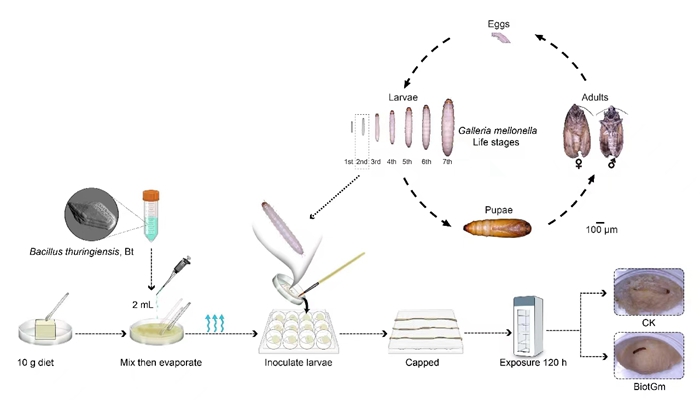Greater wax moth control in apiaries can be improved by combining Bacillus thuringiensis and entrapments
Recently, a biocontrol entrapment method for the greater wax moth (GWM), a major bee pest, was developed through a joint effort of the Innovative Team for the Resource Insects Protection from Institute of Apicultural Research, Chinese Academy of Agricultural Sciences (CAAS), the Institute of Plant Protection of CAAS and other organizations. This innovative method elucidates the promising potential of a novel Bacillus thuringiensis (Bt) strain in combating GWM. The research result was published in Nature Communications.
The GWM is a pervasive pest of honey bee colonies worldwide, especially Apis cerana cerana , a bee species indigenous to China, which is vulnerable to GWM. The larvae of GWM has destructive feeding habit and can feed on combs, causing significant damage to beehives and resulting in economic losses. At present, various methods have been proposed as alternatives for GWM control, and the use of biological agents, particularly toxins from the bacterium Bt, has emerged as a potential solution. Although the potential of Bt against GWM has been acknowledged, several issues hinder its widespread adoption. Thus, the application of Bt-based biological control of GWM in beehives is still rare.
The research team developed a novel Bt strain (designated BiotGm) that exhibits strong insecticidal activity against the GWM and low toxicity levels to honey bee. According to the foraging behavior habits of GWM larvae, a unique compound that exhibits pronounced attraction to GWM larvae was identified and the companion trapping device that prevents bees from contacting the lure was also developed. Based on the above findings, an entrapment method consisting of a lure for GWM larvae, BiotGm, and a trapping device was designed. It was suggested that the method reduces the population of GWM larvae in both laboratory and field trials, and the field control effectiveness of the entrapment against GWM was over than 93%. What’s more, none of the 14 trial sites using the entrapment reported any incidence of GWM, suggesting that the entrapment effectively prevented GWM in beekeeping. This study provides a promising direction for the application of Bt-based biological control of GWM in beehives.
This research was supported by the National Key Research and Development Program and Agricultural Science and Technology Innovation Program of Chinese Academy of Agricultural Sciences.
Link to this paper: https://doi.org/10.1038/s41467-023-42946-4

-
 Apr 18, 2024Opening Ceremony of the Training Workshop on Wheat Head Scab Resistance Breeding and Pest Control in Africa Held in CAAS
Apr 18, 2024Opening Ceremony of the Training Workshop on Wheat Head Scab Resistance Breeding and Pest Control in Africa Held in CAAS -
 Apr 03, 2024IPPCAAS Co-organized the Training Workshop on Management and Application of Biopesticides in Nepal
Apr 03, 2024IPPCAAS Co-organized the Training Workshop on Management and Application of Biopesticides in Nepal -
 Mar 28, 2024Delegation from the School of Agriculture and Food Science of University College Dublin, Ireland Visit to IAS, CAAS
Mar 28, 2024Delegation from the School of Agriculture and Food Science of University College Dublin, Ireland Visit to IAS, CAAS -
 Mar 25, 2024Director of World Food Prize Foundation visited GSCAAS
Mar 25, 2024Director of World Food Prize Foundation visited GSCAAS -
 Mar 20, 2024Institute of Crop Sciences (ICS) and Syngenta Group Global Seeds Advance Collaborative Research in the Seed Industry
Mar 20, 2024Institute of Crop Sciences (ICS) and Syngenta Group Global Seeds Advance Collaborative Research in the Seed Industry
